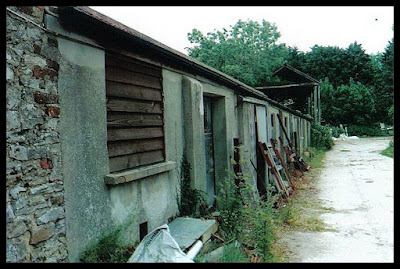A Grade II listed building of 17th century origin, it's rather interesting because of its situation right in the centre of the village amongst other houses and cottages, with no fields surrounding it. However, I did see a tractor going in and out with loads of hay earlier on the same day when I went to have a look at the little church (in the previous post) in June 2010, therefore the farmed lands must be around the edge of the village.
I do love farms and this one has some very old buildings with some interesting features. Some oddities too, prompting further questions.
This building has been adapted for modern use with the steel doors, but still shows the remains of its older self with the brick arch above the doors. The wooden slats in the top window was used for controlling the air flow. This is specifically seen in places such as tanneries and curriers, where the air flow was important for drying purposes. This may have been used for keeping hay and grains aired, but possibly another, older and now unknown usage.
The
adjoining building, above, shows some features which are usually associated with
WW2 airfield buildings, especially the concrete buttresses. I don't know of
any WW2 construction in this particular area, although Whitford was on
the edge of the Taunton Stop Line. As well as pillbox defences on the
river it was also a specific defensive area known as an Anti-Tank
Island.
Built with roughcast stone rubble with a hipped and gable-ended roof, the house is L-shaped, which can partially be seen in the above photo. There is a panelled door off centre with hood on brackets at the front; unfortunately it can't be seen on my photos as it's hidden behind the hedge. Rendered ridge and end chimneystacks.
Not a lot of information about this particular building, but a lovely little meander anyway. :)








I was born in Whitford just down the road from this farm in a cottage called Greenhaze (not sure about the spelling) I was owned by the James family, I remember Reg very well, they kept milking cows and some pigs. The pigs were kept across the road, the gate was on the left as you went up Colyton hill, they had an orchard that the pigs were kept in and buildings. The fields for the cows to go into would have been past the village hall along Park Lane. They had two children a daughter called Elizabeth and son called Norman. cookiecrumble@john-lewis.com
ReplyDeleteThank you very much for your comment. It's always interesting to get some background on buildings, especially your description of how where the fields were. I remember seeing an old orchard nearby (up the road from the chapel, if I recall properly), which looked as though it had been abandoned. I took a few photos of it, too. :)
ReplyDeleteMichael. W.
ReplyDeleteWihtford
Me.
Wiltshirecouncil
ReplyDeleteMichael. Whitford
M. W
Britain
ReplyDeleteMichael. Whitford. new. B.
ReplyDeleteHi Michael. I am sorry but I don't understand your comments. Thanks for getting in touch, though, and I hope you enjoyed the article. :)
ReplyDelete